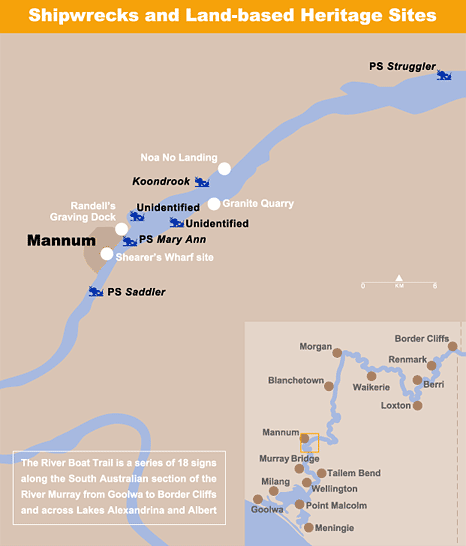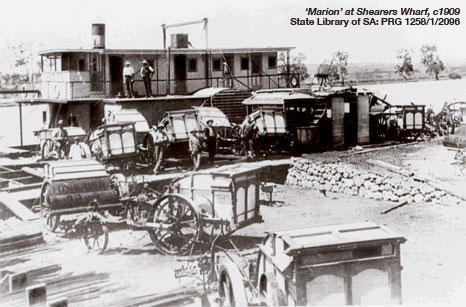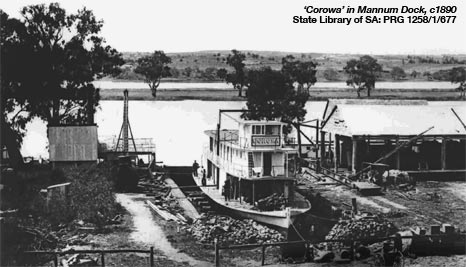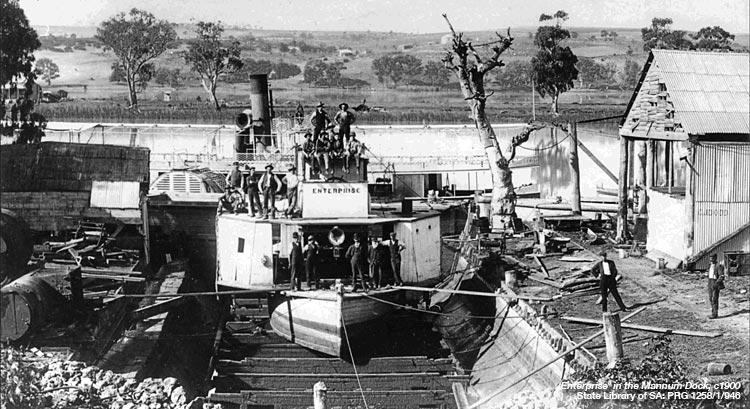
Mannum is the birthplace of Australia's steam era
 Port of Mannum
Port of Mannum
Birthplace of steam navigation on the Murray
On 19 February 1853, at Noa No Landing north of Mannum, William Randell launched the Mary Ann, the first paddle steamer on the River Murray. He later moved his operations to the present site of Mannum, which soon became a centre for shipbuilding and river transport.
Randell built a wharf, goods sheds and fleet of river boats. By the 1850s and 60s, up to 20,000 bales of wool per season were unloaded at Mannum, to be transported overland to Port Adelaide. In the 1870s Randell installed a dry dock (now a feature of the Mannum Dock Museum) to assist with shipbuilidng and repair.
As Mannum thrived, businesses were attracted by the transport network the river provided. Benjamin Walker built a flour mill in 1876 and a year later David and John Shearer established a blacksmith and implement business in the town. Both industries used the river system to market their products.
The Shearer brothers built their own wharf and made good use of river steamers to expand their markets upriver in South Australia as well as Victoria and New South Wales.
Another colourful river captain, J.G. Arnold, also based his fleet of paddle steamers in Mannum. He built the large paddle steamer Mannum and the Gem and Marion, which ran until 1947.
The Mary Ann Story
William Randell and his brothers were flour millers who recognised the benefits of trading along the river. Although they had never seen a paddle steamer, they constructed a hull and a boiler and carted them across the hills from Gumeracha.
The brothers assembled the vessel on the riverbank at their father's Noa No Station and installed an engine made in Adelaide. The end result was the 55-foot steamer Mary Ann, which was named for their mother.
The boiler was rectangular with a furnace through the middle. when it was first tested it bulged as the steam built up and Randell wrapped bullock chains, tightened with wooden wedges, around the outside.
 First Voyages
First Voyages
William Randell skippered the Mary Ann on a successful trial on 19 February 1853, thus marking the appearance of the first steamer on the River Murray.
He then planned a trading voyage and had twenty-one tons of cargo carted from Gumeracha. As there was no customs officer at Noa No, William had to first steam downriver to Goolwa to clear his cargo.
The Mary Ann set off from Noa No on 25 March laden with a cargo of flour, sugar, tea, tobacco and sundries.
Unfortunately it was a drought year and this as the middle of the low-water season. The vessel travelled only 200 kms before it needed to turn back.
Encouraged by this voyage, Randell set out again on 15 August once the water levels had impoved. Just past the Murrumbidgee junction the Mary Ann was overtaken by another steamer, much to the crew's surprise! This was Francis Cadell's Lady Augusta that had left Goolwa on 25 August.
The Mary Ann eventually reached Swan Hill on 17 September 1853 and proceeded upriver as far as present-day Moama - a journey over 1700 kilometres from Goolwa.
The Mary Ann's Fate
In 1855 William Randell used the hull of the Mary Ann to build the twin-hull paddle steamer Gemini. Later, the Gemini's newer hull was rebuilt as the Nil Desperandum and the older hull (the former Mary Ann) was abandoned near Mannum's old ferry crossing. The Mary Ann's unique boiler spent many years on display at the public reserve but is now housed at the Mannum Dock Museum. A replica boiler has replaced it as the reserve.
Noa No Landing, the launch site of the Mary Ann in 1853, is a significant State Heritage Place protected by the Heritage Places Act 1993.
 Randell's Dry Dock
Randell's Dry Dock
This graving dock is the only one of its type on the River Murray. It was used to maintain and repair at least half of the steamers that ran on the Murray and Darling Rivers between 1900 and 1927.
Originally a floating dock, Randell's Dry Dock was built by shipwright 'Little Tommy' Smith for A.H. Landseer in Milang in 1873 and described at the time as the largest floating dock built in the Southern Hemisphere.
A floating dock has watertight compartments to enable the dock to submerge (to allow the boat to enter) and then float, which means it can be moved. A dry (graving) dock is fixed and cannot be moved.
The dock was built of redgum, with internal frames an a single outside layer of planking, similar to the hull of a wooden ship. Twelve trestles were fitted to the bottom to support the vessel being repaired. The dock was calculated to lift 1000 tons but was unable to sink low enough in the shallow waters to take on most vessels.
After several years the dock was purchased by William Randell and towed to Mannum. He claimed that it moved like a snake when towed.
At Mannum the dock was fitted into an excavation in the bank as a fixed dry dock. A traction engine driving a centrifugal pump was used to empty the dock at a rate of 40 000 gallons per hour.
The first vessel, the PS Lady Daly, entered the dock for repairs on 6 June 1876, but it was found that the structure was leaking.
The dock was rarely used until 1880 when major repairs were undertaken at a cost of about £1500. This included driving 130 piles through the floor to stop the dock rising when empty and lining it with 60 000 feet of redgum. It was reported that the dock was to be made four feet wider by removing the southern ballast tank and this appears to have been done as the extreme width of the present day dock agrees with the original width of 40 feet.
From November 1880, beginning with repairs to the paddle steamer Corowa, the Randell Dry Dock had a productive 47 years as the only dry dock on the Murray River. It was available for river steamers of any size and draught, and within just five years of operation had repaired a total of 69 vessels.
Captain J.G. Arnold took over the dock in 1911 and it continued to flourish until the opening of a slip at Morgan in the late 1920s, with the last commercial use of the dock being for repairs to the PS Marion in 1927.
In the 1990s, the historic dock was restored as part of a successful community project to restore the PS Marion. Over 500 cubic metres of debris and sludge was removed to reveal the timer walling, trestles, hinged gate and rollers.
Specifications:
Length: 140 feet (42.7m)
Width: 40 feet (12.2m)
Depth: 12 feet (3.7m)
Total weight: 350 tons

Randell's Dry Dock is a significant State Heritage Place protected by the Heritage Places Act 1993.
| Mary Ann Reserve GPS: Zone 54 E 0345795 N 6135020 Panel southern end of the Mary Ann Reserve |
Mannum Dock Museum GPS: Zone 54 E 0346188 N 6135610 Panel adjacent to the dry dock, within the Mannum Dock Museum |
Interpretive panels are located at:
River Boat Trail | Border Cliffs | Renmark | Berri | Loxton | Waikerie | Morgan | Blanchetown | Mannum
Murray Bridge | Tailem Bend | Wellington | Meningie | Point Malcolm | Milang | Goolwa
Please do not interfere in any way with ship-wrecks and land based heritage sites
Published with permission of Government of South Australia
Department for Environment and Heritage
Tell your friends you found this at murrayriver.com.au!
Copyright Discover Murray 2025. This site or any portion of this site must not be reproduced, duplicated, copied, sold, resold, or otherwise exploited for any commercial purpose that is not expressly permitted by DISCOVER MURRAY.






 The Royal Edinburgh Military Tattoo 2023 - Arts On Screen
The Royal Edinburgh Military Tattoo 2023 - Arts On Screen An Afternoon Of Classical Piano
An Afternoon Of Classical Piano CREEDENCE CLEARWATER COLLECTIVE
CREEDENCE CLEARWATER COLLECTIVE Big Band Christmas Bash 2023
Big Band Christmas Bash 2023